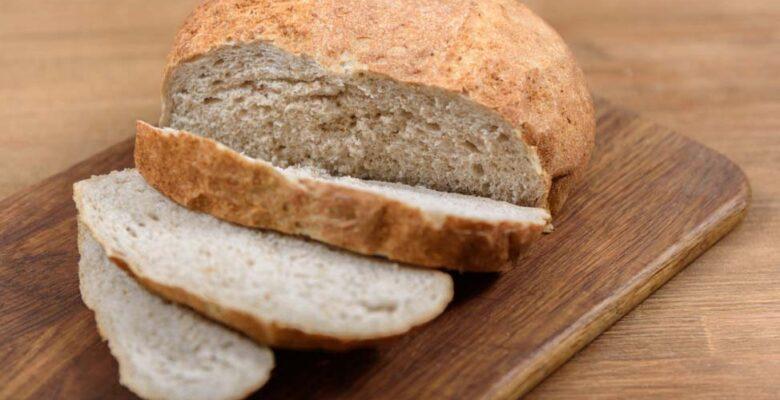I used to spend my Sunday mornings working at a bakery, mixing up twenty-pound batches of brioche and shaping hundreds of soft rolls alongside a crew of three other bakers. We took turns making one another coffee and catching up on any new life updates since our 4 am shift the day before. Ten hours later, I’d change clothes and drive to church in time for a late afternoon service. With arms still covered in bits of dried dough, I’d walk forward to receive the Eucharist. Week after week I began to wonder if the bread I made on Sunday morning had anything to do with the bread I consumed in church later that day. This curiosity led to years spent studying the role of bread in Scripture and throughout history. Here’s a sample lesson from a curriculum developed as a result.
Introduction
Whether it comes from a grocery store or the farmer’s market stall, made fresh in your home kitchen or delivered to your doorstep from a friend, whether it’s gluten-free or gluten-full, sourdough or sweet, bread is an important part of daily life for most people around the world, today and throughout history. Bread shows up all over Scripture and in our weekly liturgy.
But what does the bread we share on Sunday have to do with the bread we eat the rest of the week?
Let’s find out.
Step 1: Ponder
Read Luke 24: 13-33 and ponder these questions with me.
- I wonder what Jesus looked like to the disciples during their walk?
- I wonder how Jesus’ teaching on the road changed the way the two disciples thought about the Messiah?
- I wonder how it felt for their hearts to burn within them while Jesus talked?
- Jesus “took the bread, blessed, and broke it,” and then they recognized him. I wonder, why then?
- I wonder what it felt like to recognize Jesus?
- At the end of their walk, the disciples asked their mysterious guest to stay and have dinner with them. When they sat down, Jesus took the bread and blessed it and broke it. Does that remind you of any other stories?
This meal helped the disciples to remember Jesus. When they shared the bread, they realized it was Jesus who had been walking with them all along!
In the Gospel of John, we learn that Jesus is the Word of God and also the Bread of Life. We can use words to talk about God, and we can use words to talk to God. Jesus used words to talk with the disciples, and their hearts were warmed. But sometimes it takes more than words to fully understand what it means for God to be with us. Sometimes we need to taste and feel, to know with our hands and our tummies that God loves us, provides for us, and walks with us. The special gift that God gives us to show us this kind of love is bread.
When we are sad or scared, we can take bread and say grace over it too, and remember that God is near.
Step 2: Play
Play a game of charades where each person must take a turn acting out a book, movie, or television character. At the end, discuss how you recognized which character the child was, even if the child didn’t look like their character. The disciples didn’t recognize Jesus by his looks, and they only slightly recognized him by his teachings. But when he performed the actions of taking, blessing, breaking, and sharing the bread, they knew exactly who he was.
Step 3: Bake
Short Cut “Sourdough”
3 cups all purpose flour
1/2 cup whole wheat flour
1 teaspoon salt
1/4 teaspoon instant yeast
1 1/2 cups water, warm to the touch
- In a large bowl, mix together flours, salt, and yeast. Form a well in the center and add the water.
- Mix together until the water is completely incorporated into the flour. Let rest for 8-12 hours. Because this dough has such a small amount of yeast, you have a lot of room for flexibility with this timing. If you need more time, you can even pop it in the fridge for up to 24 hours.
- After the dough has rested at least 8 hours and up to 12, pour the dough onto a counter top lightly dusted with flour. Fold the dough in half vertically, then again horizontally.
- Let the dough rest for 10 minutes then repeat the process of folding in half again. Gently shape the dough into a round with your hands and place on a baking tray.
- Let the dough rest on baking tray uncovered for half an hour.
- While the dough rests, preheat the oven to 450°F. After half an hour, slice a cross in the top of the dough, about half an inch deep.
- Spritz the top of the loaf lightly with water just before putting it into the oven.
- Let bake for 30 minutes, until the crust is golden brown.
- Let cool completely, then slice and enjoy!
Curious to learn more about the role of bread in the Gospels and in Christian practice? Bake with the Bible is for you. This six week curriculum is great for Sunday school, youth group, or intergenerational formation. Learn more at Edible Theology. Interested in purchasing a license for the churches in your diocese? Reach out to Edible Theology directly at [email protected].


Photo by Andrii Omelnytskyi on Scopio.
Editor’s Note: This article was updated on March 6, 2023 to repair the link to Edible Theology.

